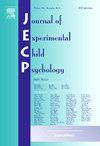Preschoolers’ use of emotional prosody in an unfamiliar language
IF 1.8
2区 心理学
Q3 PSYCHOLOGY, DEVELOPMENTAL
引用次数: 0
Abstract
Rapid and accurate recognition of another’s emotions is critical to successful communication. Previous research indicates that preschoolers can use emotional prosody in familiar languages to identify an object being referred to by a speaker (i.e., associate a happy tone with an intact object and a sad tone with a broken object). Here, we examined whether listeners’ use of emotional prosody is tied to language comprehension by testing English-speaking preschoolers’ and adults’ use of emotional prosody when presented with utterances spoken in Arabic. In Experiment 1, 4-year-olds listened to a series of happy- or sad-sounding Arabic utterances while simultaneously viewing a visual array of objects that varied in their association with happiness or sadness (e.g., broken vs. intact toy). In contrast to previous studies in which listeners heard English utterances, results suggested that children were unsuccessful at implicitly (demonstrated via eye gaze) or explicitly (demonstrated via pointing) linking emotional intonation with corresponding objects. A second experiment demonstrated that 4-year-olds could, however, successfully match the same emotional utterances with happy or sad faces. Experiment 3 examined these abilities in English-speaking adults using the same materials. Adults correctly linked emotional prosody to both objects and faces. Taken together, the findings demonstrate that both 4-year-olds and adults can correctly categorize emotional intonation in an unfamiliar language. Only adults, however, were successful at using emotional prosody to help identify an object a speaker is referring to. These findings demonstrate developmental differences in the use of emotional prosody.
求助全文
约1分钟内获得全文
求助全文
来源期刊

Journal of Experimental Child Psychology
Multiple-
CiteScore
4.50
自引率
7.70%
发文量
190
期刊介绍:
The Journal of Experimental Child Psychology is an excellent source of information concerning all aspects of the development of children. It includes empirical psychological research on cognitive, social/emotional, and physical development. In addition, the journal periodically publishes Special Topic issues.
 求助内容:
求助内容: 应助结果提醒方式:
应助结果提醒方式:


